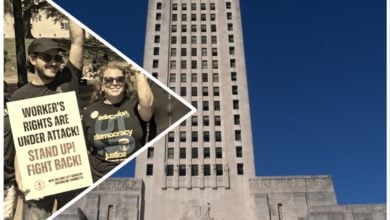The absence of coverage of the tremendous people’s struggle in Haiti by U.S. media is nothing new. The self-declared dictator Jovenel Moise has been in power for a year after the end of his presidency with the support of the U.S. government and other imperialists.
From reports on the ground in Haiti today, the struggle has reached a point where the Haitian people see the direct ties between U.S. imperialism and the current dictatorship.
As the Haitian people carry out an uprising in the streets of Haiti, they know that their liberation is tied to ours in the United States. They are calling on all working and poor people in the U.S. to support them in defeating imperialism.
This sentiment of joint struggle goes back two centuries and more.
The 1811 Rebellion
On a rainy January night in 1811, nearly 500 hundred enslaved people revolted outside of La Place, Louisiana. This rebellion was both inspired by and in many ways directed by the politics of the Haitian revolution (1791-1804).
Named the German Coast Rebellion of 1811, it is rarely cited or taught in school. The white supremacist cleansing of history leaves out this important event; the U.S. ruling class has taken every step to attempt to erase this long history — to limit the consciousness of Americans on the possibility of a revolution in the United States.
To show the significance of the rebellion, the governor of Orleans prohibited slaves from traveling from one plantation to another. Other severe laws were enacted to increase social control.
“I realized that the revolt had been much larger — and come much closer to succeeding — than the planters and American officials let on,” wrote historian Daniel Rasmussen after extensive research of court reports and plantation ledgers, which he documents in his book “American Uprising: the Untold Story of America’s Largest Slave Revolt.”
The revolt began on the plantation of Colonel Manuel Andry on the east side of the Mississippi — also called the German Coast as many of those slave owners were of German descent.
Led by Charles Deslondes, a slave driver of Haitian descent (often smaller plantations used Black slave drivers to save on cost), they overcame the slave owners, killing one and wounding another. The group armed themselves with muskets and ammunition from the plantation’s basement.
Later as the revolt grew, many had no muskets but carried farm tools and just about any object that could be used as a weapon. They marched along River Road, burning other plantations along the way to New Orleans in the hopes of meeting up with revolutionaries there and beyond.
“Charles knew that uniforms would lend the revolt authority, wedding their struggle with the imagery of the Haitian revolution, whose leaders had famously adopted European military garb,” wrote Rasmussen.
But this revolt did more than depict the imagery of the Haitian revolutionary struggle, it threatened the slave-owning class’s control of New Orleans.
The ranks of the slave revolt grew to more than 500. More than half of the rebels were born in Africa — speakers of West African languages like Twi, as well as Bantu languages from Angola. Some had previous military experience from their lands of origin.
The highly organized revolt’s intention was to create a Black Republic in Coastal Louisiana. No doubt inspired by Haiti — where enslaved people had overthrown the slavocracy and taken state power.
The rebellion reached what today is the city of Kenner — 13 miles outside of New Orleans — as slave owners abandoned their plantations, fleeing to New Orleans. William C. Clairborne, governor of the Territory of Orleans, decreed a virtual martial law shutting down all the bars in the city.
With uniforms, marching in formation, as the rebel army’s ranks swelled, they were confronted by U.S. federal troops. As they were retreating, they were cornered by the militias of the slave owners, organized by the surviving Colonel Andry — who had escaped after the initial attack.
The rebellion was brutally crushed. It was a bloodbath. More than five dozen perished in the initial fighting. Ninety-five were executed. Some escaped to the swamp to later join maroons. In the retreat, Deslondes was captured, tortured and then executed. The heads of the leaders were put on poles along miles of the road as a warning to enslaved people to never step out of line again.
This hidden history becomes especially important in this moment when the Haitian people call on those in the United States to mobilize and organize against U.S. imperialism and to stand in solidarity with them in their struggle to see a truly independent, sovereign and democratic Haiti.
The imperialist ruling elite in the United States knows that this kind of internationalist solidarity is a threat to their rule both at home and abroad. Freedom fighters like Charles Deslondes and the hundreds of other revolutionaries of the 1811 rebellion too knew this.
The time is now to stand with Haiti. Down with U.S. imperialism! Free Haiti!
Please check out BreakThrough News for an eyewitness report on Haiti, as well as this episode of the Socialist Program for coverage of the current uprising in Haiti.





